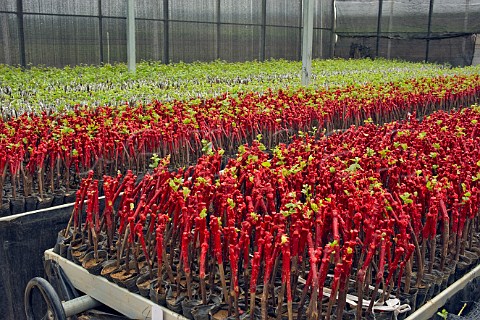Explore grafting and rootstock combinations

The rootstock introduced in viticulture to avoid the effects of phylloxera attacking the roots of V. vinifera is the part of the bimember plant that mediates the needs of the aerial part of the plant with the soil. The selection of genotypes with the function of rootstocks is essentially made on the basis of the tolerance manifested towards phylloxera attacks and only afterwards the different behaviors of greater or lesser tolerance to abiotic stresses are evaluated, such as the ability of vegetating at best in unfavourable conditions of soil pH, the presence of CaCO3, nutrient absorption efficiency and management of the water available in the soil.
An adaptation option to climate change is the choice of rootstocks selected for their drought tolerance. This choice determines the development of the plant, the quality and the volume of the harvest. It is determined by (1):
- The level of active limestone in the plot (chlorosis resistance)
- The water regime of the plot (root system adapted to the risk of drought)
- Plot soil depth (volume of soil colonized by root system)
- The vigour of the rootstock (quality and yield objectives of the winemaker)
- Its early maturity (defines the ripening speed of the grape)
With respect to water stress there are two physiological behaviors of the genotypes, one of a conservative type (when H2O is limited, stomata close but photosynthesis is not active) and the second of an adaptive type (the genotype is able to modify the opening of stomata according to the water available and able to carry out photosynthetic activity). Another important factor is the geotropic angle of the roots, the higher ones lead roots to remain more superficial in areas of the ground with less water availability, while those with a smaller geotropic angle drive roots closer to the projection of the stem but in depth, by exploring areas of the land that are generally more equipped with water. Today the available rootstocks can be distinguished by their different behaviors, with the V. Rupestris X V. Berlandieri hybrids more suitable for drought areas, while in the new genotypes the M4 rootstock (41 B X Rassenguier 1, V. berlandieri) is particularly suitable to water stress situations.
The rootstock has the advantage of being much less regulated in its use by winegrowers than are grape varieties: the grape variety often meets a specification of appellation and a requirement of typicity.
The table below shows an overview of the characteristics of the vine rootstocks by VCR (Vivai Cooperativi Rauscedo)
- Techniloire - Bien choisir son porte-greffe. https://techniloire.com/sites/default/files/fiche_choisir_son_porte_greffe.pdf
Davide Bianchi, Daniele Grossi, Giovambattista Simone Di Lorenzo, Yang Zi Ying, Laura Rustioni, Lucio Brancadoro. Phenotyping of the “G series” Vitis hybrids: First screening of the mineral composition, Scientia Horticulturae, Volume 264, 2020, 109155, ISSN 0304-4238, https://doi.org/10.1016/j.scienta.2019.109155
Davide Bianchi, Daniele Grossi, Davide T.G. Tincani, Giovambattista Simone Di Lorenzo, Lucio Brancadoro, Laura Rustioni, Multi-parameter characterization of water stress tolerance in Vitis hybrids for new rootstock selection, Plant Physiology and Biochemistry, Volume 132, 2018, Pages 333-340, ISSN 0981-9428, https://doi.org/10.1016/j.plaphy.2018.09.018.
I Portinnesti della serie M e la risposta della vite al cambio climatico https://fondazionebanfi.it/php/dl.php?id=341&md=2792
Σχέσεις
- Δίκτυο
- Λίστα
- Γεωτοποθεσία
- Περισσότερα
Vinipôle Sud Bourgogne - Une plateforme d'expérimentation autour du Changement climatique en Viticulture et Oenologie
Nous sommes un lieu d'expérimentation et de conseil sur le changement climatique en viticulture : Matériel végétal, protection des plantes, réduction des consommations d'eau et d'énergie dans les chais, suivi et anticipation des aléas climatiques.
